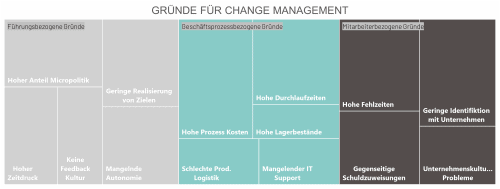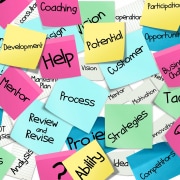Sustainable change management
30.10.2021
Until the 1960s, upper and middle management were oriented toward the cybernetic control loop as a fundamental management model. Deviations from the norm were regarded as controllable or regulable by means of “correct” methods. But the changes became more profound, more comprehensive and increasingly rapid. The so-called “disturbance” thus became the normal case, and regulating or remedying it became increasingly costly and complex. Management no longer comes to “rest”, but is an object of constant adaptation to changing conditions.
Yesterday’s recipes for success are no guarantee of tomorrow’s success
What was gently called “change” 20 years ago has today undergone a rapid acceleration, so that some would like to speak of a “revolution”. Economic history shows new phenomena, such as globalization, new work, Internet, multimedia, etc.. These then led to new terms such as, Change Management, Leadershift, Chaos Theory or Business Transformation.
Yesterday’s recipes for success are no longer a guarantee for tomorrow’s success. Many new tools and models are offered: Lean Management, Learning Organization, Knowledge Management, Design Thinking, Agile way of working, and many more.
Suddenly, employees, executives in upper and middle management had to deal intensively and directly with the topics of change, permanent learning, disruption, new formats and chaos management. This inevitably led to a loss of familiarity, status and control, and caused uncertainty. From this state of affairs, a new “recipe”, change management, was established. Change was not only to be seen as necessary and inevitable, but was also to be actively shaped.
Employees not only had to be made less afraid of the new, but they also had to be won over as essential building blocks in the change process and allies for the new.
Change Management – all dimensions of change
As a kind of “container term,” change management is not as clearly definable and adaptable as project or quality management. Management of any kind aims at change. In this respect, all the great concepts of recent economic history were and still are part of change management – Taylorism as well as Lean Management or Knowledge Management. Even more: every merger, reorganization, and even well-managed employee appraisals, every suggestion for improvement or management review meeting is about change. In this respect, the question arises: What is not change management?
In Anglo-Saxon literature, change management is primarily understood as the human dimension of a change. In German-speaking countries, on the other hand, technical aspects are also taken into account. This leads us to the conclusion that change management is about technical, strategic, organizational, managerial and human-social changes, which are realized with a multiple combination of hard and soft factors.
Consequently, the essential task of a change manager is to manage people, information, resources and processes in a targeted manner in order to bring about change and adaptation. The main focus is on human resources management, because changes – as proven by our own projects – are met with resistance, cause fears, resilience and learning blockades.
Another finding from many of our own projects is that change is not possible without the participation of employees.

Source: Study Institute for Learning Organization and Innovation, Munich in cooperation with the Institute of Business Administration of the University of St.Gallen
All approaches to change management pursue a common concern: they should create “infrastructures” for change. It is not the changes alone that are important, but their implementation and the provision of a climate and environment conducive to realization. Above all, proactive change management strives to create a change-friendly climate in which new ideas and concepts can emerge.
It’s not just about the new
Today’s change management also aims at continuous sustainable corporate development. In addition to growth or consolidation, revitalization, reorganization, accountability or value enhancement are among the common objectives for the development of organizations. Today’s goal is to create structures in management and a mindset that shape change itself and are no longer fixated on constant constancy. Consequently, in the change process a company should not only acquire the ability to change its own rules according to the learning process, but at the same time to develop rules for the rule changes and thus to become reflexive.
Change Management – step-by-step
Models and concepts for a successful approach to change management can be considered from two main points of view – to change the content and direction, companies should work with common models in terms of content and concept, with Business Reengineering, Lean Management, Total Quality Management or Balanced Scorecard dominating the opportunity scene here so far. When it comes to the question of “how”, there are two answers. Depending on the point of view or the basic model, a more management-technical approach is interested in the typical course of a change process. For the phases of diagnosis, goal formation, planning, decision, realization and for sustainable support control. Human resources managers, for example, tend to focus more on the actors involved in the change and ask about the necessary motivational resources.
Usually, such a process goes through several phases until the psychological changes are stably adopted into the behavioral or attitudinal repertoire.
The Company Journey Guides proceed with minor deviations from the generally accepted seven-phase model:
Shock – Rejection – Insight – Acceptance – Trial – Realization – Integration. Change Management step-by-step.
Extensive changes, such as transformations, cover a period of at least 24 months. In each of the phases mentioned, a different set-up and procedure is useful.
From our point of view, supporting consulting/coaching and facilitation play an essential role for a successful change. This creates a suitable methodological, spatial and temporal structure and ensures sustainability. A facilitator is therefore first and foremost a process designer and structure provider, completely neutral in terms of content and impartial. He/she has a high level of competence in relation to change, groups and conflicts and has a well-stocked toolbox of methods for conversations and creative processes in meetings, workshops and conferences. Thus, he/she is able to pick up people from where they currently stand.
Interested?
We are here for you.








